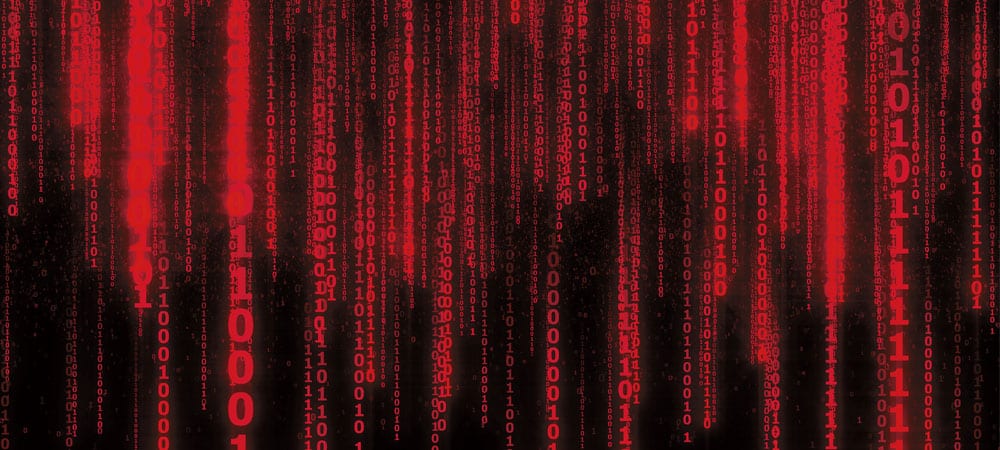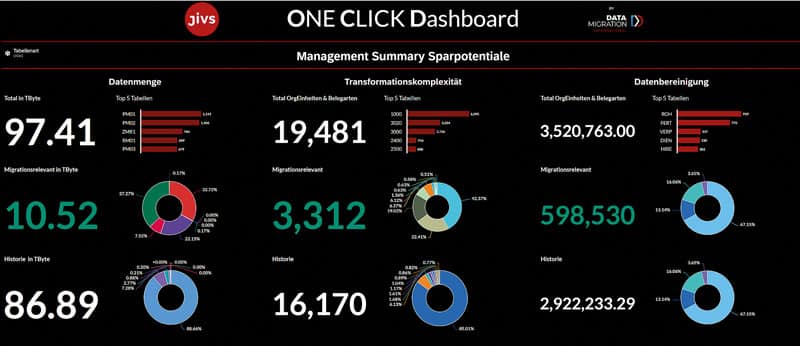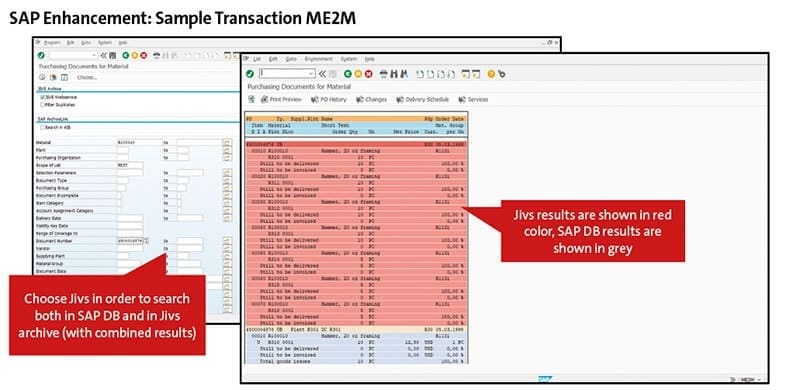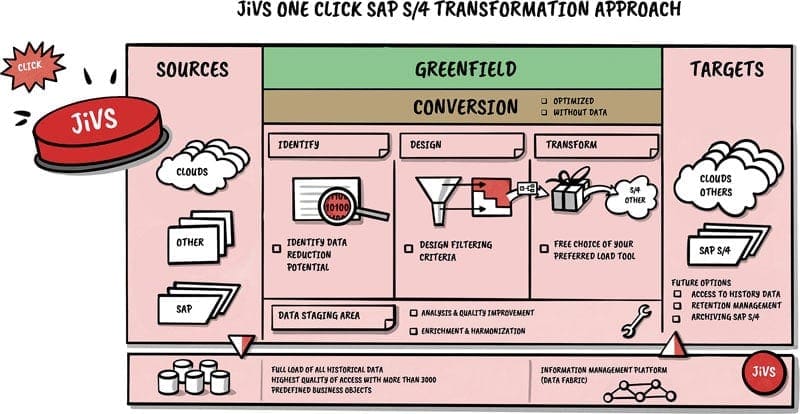Transformation: new and radically simple


Demand for SAP transformation projects is really taking off. In theory. But in practice, existing SAP customers are encountering a key obstacle: the shortage of SAP consultants and migration specialists - worldwide. There are already increasing reports from the market that some SAP migration companies will not be able to accept new transformation projects for at least another year. It is feared that by 2025 at the latest, every available SAP migration specialist would have to work around the clock to keep up with demand.
Of course, this will not happen. But what will happen instead is clear: Daily rates will rise sharply, and project times will become much longer. This is not a good starting point for the digital transformation of major SAP customers in German-speaking countries, for whom the switch to the new software generation from Walldorf is the core of their digitization strategies.
S/4 Conversion: A Brief Theory of Colors
In addition to consultant capacities, the question of the transformation approach must be clarified. In recent years, it has become a convention to assign colors to the various approach options. The color spectrum ranges from Brownfield to Greenfield with many different shades in between. At one end of this spectrum is Brownfield. This refers to the complete transfer of the previous data structures, business objects and individual customizations as well as in-house developments, including the complete legacy data stock.
At the other end, the greenfield restart beckons. In this approach, known as greenfield, companies start fresh with data structures, business objects and customizations as they see best for their own business future. In this approach, if companies want to take data from legacy systems, they have two options: Either they transform all of that data, with great difficulty, or they transform only the master data and open items. In both cases, however, the original data accumulated to date remains in the legacy systems, which then have to be operated in parallel for longer periods for legal and business reasons.
Brownfield Dilemma
Both extremes have their justification, but also considerable disadvantages. Companies with a homogeneous system landscape, i.e. without external systems and different release statuses, which do not want to change their previous business and therefore consciously forego changes and innovations, will find their optimal method for the transformation to S/4 Hana in Brownfield.
However, the system landscapes of large SAP customers are usually so heterogeneous and the databases so extensive that their conversion at Brownfield appears to be straightforward from a technical point of view. However, appearances are deceptive, because a large number of prerequisites have to be created in the source systems, in some cases in time-consuming preliminary projects. This includes, among other things, the cleanup of individual developments or the activation of new business logic.
Exorbitant costs included
In addition, many test runs are necessary, during which the specialist departments must also be involved in order to avoid errors. In addition, the conversion of the usually very large volumes of data usually requires immense computing capacities, including high costs. Against this background, it is probably no longer surprising that many existing SAP customers struggle to justify the business case for an SAP transformation project.
Even more serious from a business perspective, however, are the dependencies between the data, its structures and source systems, but also from interfaces between different systems. Incidentally, this also includes those data that are, for the most part, unfortunately hardwired to obsolete or numerous organizational units, document types and processes that are no longer relevant. In many cases, this data is likely to account for up to 90 percent of the total data inventory. In fact, the dependencies are so great that they can make the chance of
to a new start or the foundation for new business models and processes, which management in most cases associates with the generation change.

Little chance of success
Incidentally, solving this fundamental problem of dependencies has only minimal chance of success, whether companies try to solve it at the source system level, i.e. before the changeover, or afterwards: This is because it is virtually impossible to clean up master data with relationships to outdated data structures, let alone arrive at a harmonized, i.e., cross-system, view of master data, which is usually distributed across several different source systems. The reason is that SAP legacy customers have to deal with extreme dependencies in this process, such as thousands of documents that are not closed; in some cases, it may not even be possible to get the data out of the archives, whose technology in many cases dates back to the 1990s.
In short: The linking of master data with transaction data and individual adjustments in the legacy systems prevents or at least massively complicates their cleansing. And since the relevant master data is usually found in not just one, but several and different systems, the problem is magnified. This is because these different master data from different systems would first have to be harmonized before conversion, which in turn prevents the dependencies. The vicious circle is perfect. Overall, however, the effort involved is practically unjustifiable for both the business departments and IT.
Lack of resources and competence
In a classic brownfield scenario, existing SAP customers who nevertheless attempt to at least clean up their master data after switching to S/4 will have to engage their business users to do so. But be careful: If we assume that a business user needs ten minutes to check and clean up a master data record, the company will have to schedule over 10,000 working days for this task if it has 500,000 individual master data records and assumes an eight-hour day. Of course, this task can be spread over many shoulders. Nevertheless, the effort involved is considerable. Whether these attempts at manual data cleansing will be crowned with success, however, is literally written in the stars. This is because the problem of linking different types of data with each other and with the systems exists not only in the source systems, but also in the target systems. Solving the problem there is also hardly possible from a technical point of view.
Things don't look much better when it comes to transaction data. The ERP landscapes of major SAP customers in German-speaking countries have grown over the past ten to twenty years. Even if we assume that the companies need the data from the entire past year in S/4 for further processing, they convert 90 to 95 percent of the data in a brownfield approach for nothing. What's more, this legacy represents a crushing legacy for the new system, tying up enormous computing and storage resources, leading to poor runtimes and driving up maintenance and operating costs, especially for updates or upgrades. Overall, the basis for optimizing data quality on the one hand and modernizing processes on the other is thus almost completely eliminated.
Greenfield dilemma
In contrast, Greenfield does have undeniable advantages. Especially companies with a very heterogeneous system landscape and large databases benefit from it, for example, if they completely turn their business model upside down and start over almost like a start-up. Or when they fundamentally transform their structures and processes from a centralized to a decentralized organization.
But here, too, all that glitters is not gold. Best-practice approaches that promise extensive standardization are tempting. But many existing SAP customers also fear this, as it threatens to devalue the high investments made in the customized versions of the legacy systems, including customer-specific developments and the resulting optimized processes. After all, existing SAP customers have made these investments in order to gain unique competitive advantages. The effort required to replicate these in the new software generation is enormous. Here, too, the business case usually does not pay off.
The alternative at Greenfield would be to simply transfer the open items and master data. But this very often leads to a massive acceptance problem within the company. This is because users at all levels up to the CFO want easy access to all legacy information for business reasons, and on two conditions: They want to access it from "their" interface and not jump back and forth between different solutions. In addition, the legacy
information looks exactly as if they had created it in the new system. Both conditions basically speak again for a brownfield approach, which CIOs and their management colleagues would prefer to avoid in favor of change and innovation.
Selective Data Transition
Between brown and green, a wide variety of color shades have now established themselves in terms of transformation. What they all have in common, however, is the fact that only part of the legacy data is transformed and transferred to the new world. In principle, this approach is the right one to reduce the effort involved in both the transformation and the migration. In addition, it basically offers the flexibility to optimize the future system in a kind of combination of brownfield and greenfield, independent of master and transaction data. Selective data transfer is certainly the right thing for those SAP legacy customers with a large system landscape who, despite adjustments, largely want continuity and want to build the new landscape largely on the predecessor systems.
But: The departments want to see and access all historical data in the new system as well. And they are right to do so! Companies have never needed access to their historical information, sometimes for decades, more than they do today. Digitization means that offerings increasingly consist of products, complementary services and maintenance services. Such complex offerings have life cycles of between ten and fifty years. Historical information, even if it dates back many years and is no longer changed in day-to-day business, thus acquires the same relevance for product development and the continuous optimization of offerings and their quality on the basis of data analyses as operational information.
Migration vs. transformation
But from the perspective of the project managers responsible for the SAP transformation, this wish - migration - of the business departments is unfulfillable. More than the transfer of data from the last two or three years is not possible in order to retain the flexibility to at least partially adapt and optimize the new system.
However, even when IT prevails over business, selective data transfer proves suboptimal in many cases: First, this approach works mainly when the source and target systems are very similar, i.e., when it is applied between the latest ECC version (Business Suite 7) and S/4, for example. Second, the selective data transformation tools that work at the table level can introduce the risk of inconsistencies. Who can guarantee that, among other things, the direct table-oriented loading of data records into 100,000 tables and more will be error-free in the case of large SAP environments?
It is true that this risk can be contained with a very high level of testing. But even this generally only helps to a limited extent in cleansing the data in order to optimize its quality for the new system world. Accordingly, SAP legacy customers have only limited options for ensuring a harmonized database that is fed by data from both SAP legacy systems and third-party systems.
No harmonization
However, this possibility of harmonization is an essential prerequisite for realizing the goal of a data-driven company - not to mention the fact that, with the selective data transfer approach analogous to Brownfield, a switch to the public cloud or even a (partial) switch to a third-party system is only possible to a very limited extent. The fact that data and its dependencies represent the fundamental challenge in the SAP generation change is a realization that is just now gaining ground in the SAP community. So what can existing SAP customers do? Can they really only choose between the disadvantages of the various approaches? Of course, the ideal would be a transformation path that is as technically straightforward as the brownfield approach, but as flexible as the greenfield approach.
method, where companies can cut off old braids, implement new business processes and models, and transfer only master data of the best quality into the new system. But is that even possible?
One-Click Transformation
Yes, there is a sustainable solution that not only solves old problems, but also opens up new paths. However, the prerequisite is that the transformation takes place at the application level independently of the data level. To this end, it must be possible to extract all legacy information together with its business context completely, unchanged and, above all, efficiently and quickly, and transfer it to a separate platform. After that, SAP's existing customers are free to choose whether they want to brownfield their existing application environment with all existing business objects, customizations and in-house developments via the conversion tool into the new S/4 world or greenfield it from scratch.
But what happens to the data? Basically, it would be much better to talk about historical data than legacy data, because to most ears the latter might sound as if it could be stowed away in an archive somewhere and slowly left to gather dust. But the opposite is true: Welcome to the world of Big Data and Analytics, on which the data-driven enterprise is almost vitally dependent!
Everything data driven
For this purpose, the part of the information from the legacy systems that is also required in S/4 Hana must be filtered out on a separate platform according to business criteria, cleaned up, enriched with data from third-party systems and optimized. While only five to ten percent of the transaction data usually needs to be transformed and migrated to S/4 after optimization, the amount of master data is reduced to an estimated twenty percent, which is then also transferred in optimal quality via standard tools such as SAP's Migration Cockpit. Naturally, all of this must be largely automated.
At the same time, this platform must be able to display the historical data in the S/4 world via SAP GUI or Fiori as if it had originated there. This on-the-fly transformation via the Technical Structure Mapping process - of course without changing the original structure of the historical data on the platform itself - must also take place automatically. This level of automation from data extraction to display in the new environment is the essence of a one-click transformation.

Technical Structure Mapping
Although not dissimilar to the approach of selective data transfer, the One-Click Transformation has decisive additional advantages: All information - historical as well as operational - can be cleaned up, easily enriched with data from third-party sources and optimally prepared for Big Data and analytics scenarios. Incidentally, this applies not only to movement data, but also to all master data, including the customer, supplier, item, and material masters that are so important for digital transformation.
In addition, the decision as to which information from the existing data stock should be transformed and migrated to S/4 Hana follows flexibly according to the respective business-relevant criteria of the customers. Instead of transferring all data from the last three years, for example, existing SAP customers can consciously decide to transform and migrate only the open orders and master data for customers and suppliers with whom they have ongoing business relationships.
And the CFO can also be thoroughly appeased in this scenario. Because if CFOs and specialist departments argue and sometimes annoy their IT colleagues by saying that they need all the legacy data in the new system, then there is a misunderstanding here: What they actually need is not the historical data in the new system, but "only" access to it from the SAP S/4 interface. With the One-Click Transformation approach, this is no problem. Users don't even notice when they access historical data that it is not stored in the Hana database.
A clean and transparent data set to compete in the digital economy, a massive reduction in the amount of data to be transformed and migrated, and its adoption with SAP's standard tools are just some of the benefits of this approach. In addition: Once the historical information has been transferred to the separate platform, the legacy systems and applications can be completely decommissioned. This usually eliminates 80 percent of the operating costs. The time and cost required for the actual data filtering, transformation and migration is reduced by half. The core of the software platform required for this has already been used in more than 2000 projects worldwide.
Continuous Improvement
Since the new data added to the S/4 world can be continuously transferred to the platform, the new environment and in particular the Hana in-memory computing database remain permanently lean. The savings potential that can be achieved through this continuous rightsizing is likely to be 25 percent or more over the entire lifecycle of the new environment.
And another crucial point: One-Click Transformation can also help those customers who have opted for the classic Brownfield, Greenfield and Selective Data Transition approaches and have already taken initial measures. This is because it supplements these processes with their specific advantages, starting with the identification and design of filter rules, through the historization, preparation and harmonization of data, to their integration in SAP S/4. It also enables the complete decommissioning of legacy systems, including corresponding operating cost savings.

Audit-proof incl. legacy
In all of this, legal security must not be forgotten. All historical data and documents are stored on the platform in an audit-proof manner. In addition, a platform that offers the approach of one-click
Transformation, the possibility of managing the stored information down to the level of the individual data record or document throughout its entire lifecycle until legally compliant deletion after expiry of the applicable retention periods. This also makes it possible to meet the increased legal requirements, such as the targeted deletion regulations of the European General Data Protection Regulation -(DSGVO).
The One-Click Transformation approach is characterized in particular by the consistent and continuous separation of historical data from operational data. The consistent separation between data and algorithms is also unparalleled in the market. This solves the fundamental problem of the dependencies described above. But the massive savings in transformation and operating costs, as well as the expenses for data cleansing and harmonization, are by no means everything. Because in addition, the platform that supports this approach conserves the transformation knowledge, so to speak, and makes it permanently available: for accessing historical data from within SAP S/4, for accessing historical data from non-SAP systems, and for making this data available to third-party applications such as analytics solutions.
Incidentally, transferring data to a separate and modern platform also contributes to greater security because, unlike some legacy systems, this platform can also be patched in the future. This is because many legacy systems have to be operated on old software releases and therefore usually need outdated operating systems and databases. In many cases, however, the manufacturers no longer provide any security patches for these.
In addition, such a platform can serve as a digital repository for business-relevant data and its context that is created in SaaS and other cloud solutions, but where the rights to this data are held not by the companies but by the providers of these solutions - so that access to this data is retained even after subscriptions are terminated. Finally, such a platform lays the foundation for IoT scenarios or digital twins of products, machines and plants, buildings, etc., which - enriched with operational data - can decisively improve their manufacture, operation, maintenance and management.
One-Click into the Data Fabric
All this becomes possible because such a platform keeps historical information together with its business context, but independent of its source systems. The large number of failed projects on Data Lakes, in which the business context is missing, shows that this platform approach is far better at mastering future requirements in terms of enterprise-wide data management. This brings SAP's existing customers a good deal closer to the goal of a data fabric recommended by analysts. A legally compliant platform for the lifecycle management of enterprise information from SAP and non-SAP systems is the basis for the patent-pending one-click transformation to SAP S/4 Hana and the data-driven enterprise. The platform for this is called JiVS IMP and comes from the Swiss provider Data Migration International.





